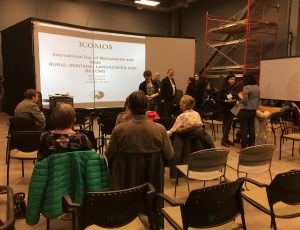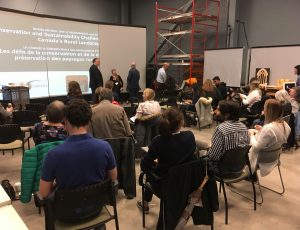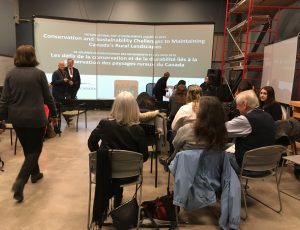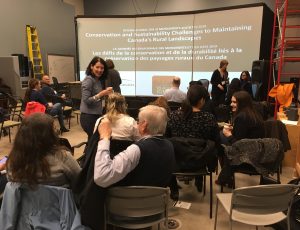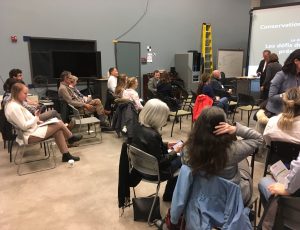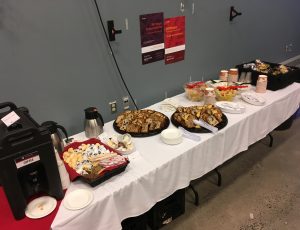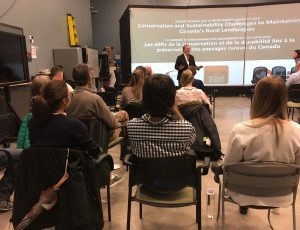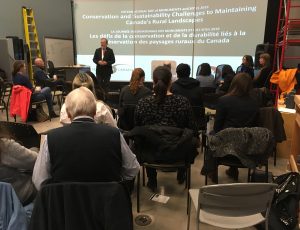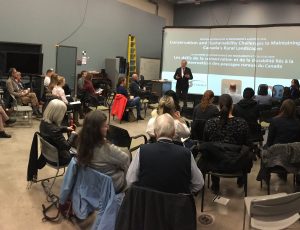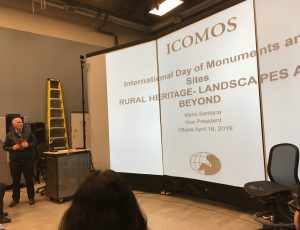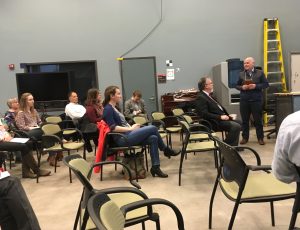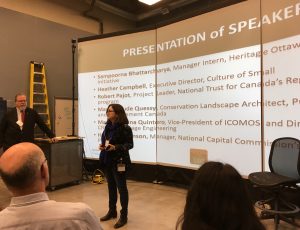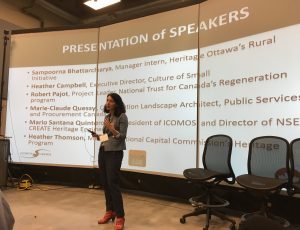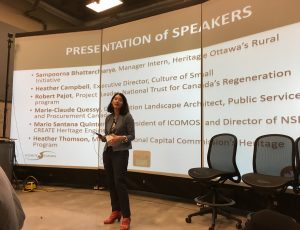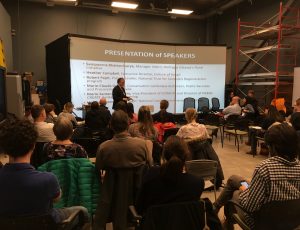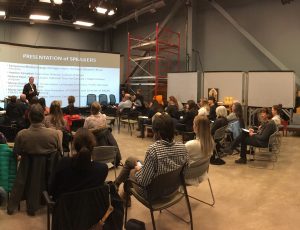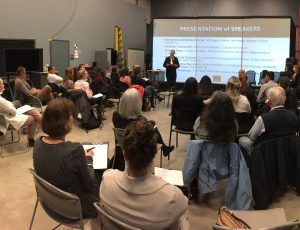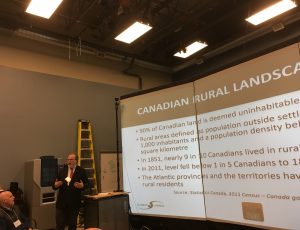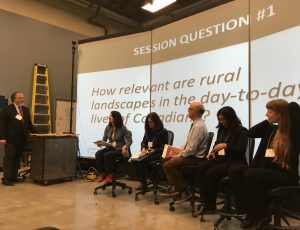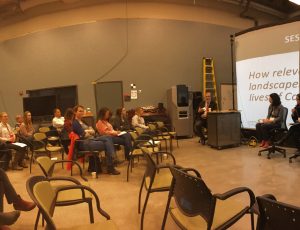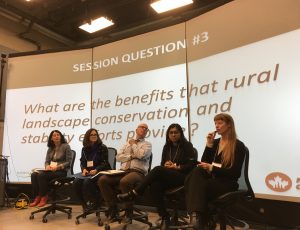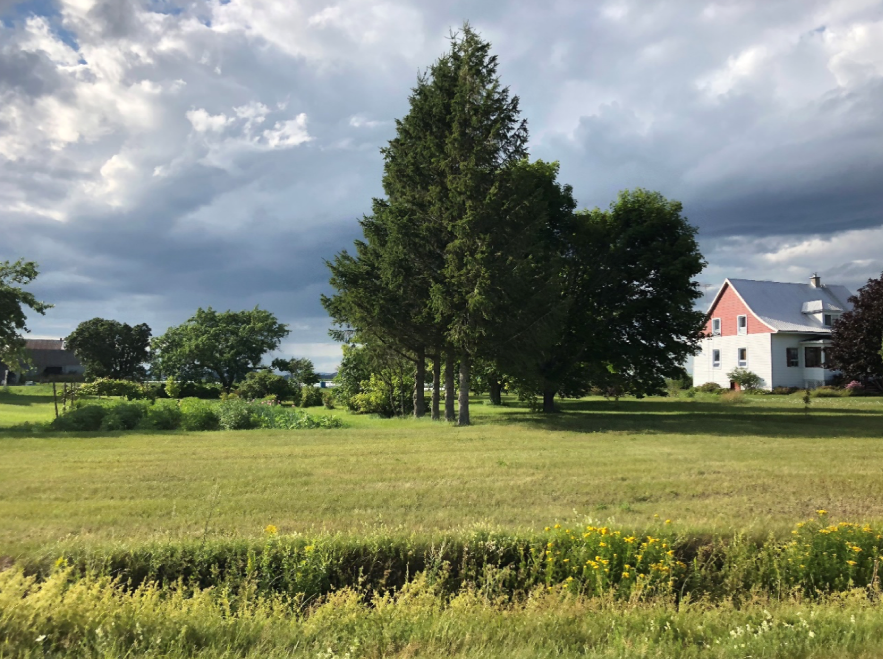
A rural property found in Gaspé, Quebec
Source: Laurie Smith
The NSERC CREATE Heritage Engineering Program hosted a roundtable discussion on April 18, 2019 at the Carleton Immersive Media Studio surrounding the theme Conservation and Sustainability Challenges to Maintaining Canada’s Rural Landscapes as part of the International Day of Monuments and Sites. The day started with a welcome from Dr. Mario Santana, Vice-President of ICOMOS and Director of NSERC CREATE Heritage Engineering, who introduced ICOMOS and described the NSERC CREATE program. This was followed by an explanation of the roundtable theme and an outline of the afternoon by Fergus Maclaren, President of the ICOMOS International Cultural Tourism Committee and this event’s moderator.
Following the outline for the afternoon, each of the 5 guest speakers introduced themselves and described their role in the heritage space.

From left to right, the speakers were:
- Heather Thomson, Manager, National Capital Commission’s Heritage Program
- Marie-Claude Quessy, Conservation Landscape Architect, Public Services and Procurement Canada
- Robert Pajot, Project Leader, National Trust for Canada’s Regeneration program
- Sampoorna Bhattarcharya, Manager Intern, Heritage Ottawa’s Rural Initiative
- Heather Campbell, Program Manager, Culture of Small
After introductions, the question period began.
*The speakers’ response to each question has been abbreviated for clarity.
Question #1 – How relevant are rural landscapes to the daily lives of Canadians?
Heather Campbell:
What about the indigenous aspect of our Canadian rural land? It is the foundation of our country. We need to provide different perspectives on rural land use and to protect our landscape.
Heather Thompson:
The rural landscape is what defines Canada and is where we are meant to connect. Canadians are currently taking it for granted until it disappears, just like what happened at the Experimental Farm. The NCC (National Capital Commission) is currently working on a barn rehabilitation strategy to make use of these rural structures.
Robert Pajot:
The rural landscapes are very relevant to the day to day lives of Canadians as it is the source of our food. Even if the landscape itself is not incorporated in our daily lives, the products are in our food.
Marie-Claude Quessy:
It may be where we live, or where we work, but the rural landscape is simply seen as an asset for planning development and to make money. This also includes the development of transport corridors that are being built wider and wider, impacting the viewspace. Work needs to be done to preserve the rural landscape viewspace.
Sampoorna Bhattarcharya:
Rural land is meant to diversify. We need to promote awareness of these spaces.
Question #2 – What are the challenges involved in their use and conservation?
Heather Campbell:
A challenge for rural landscapes is protecting their traditional uses. How do we look at their value? There’s also the economic argument. Then there’s overcoming challenges of the value these places hold.
Marie-Claude Quessy:
Rural landscapes include challenges of ecotourism. At the end of the day you still need to protect these landscapes. There are several park trails in need of repair. It is challenging for the community at the end of the year to still have enough money to pour into restoration. The development of transport corridors also has an impact on the financial benefit of the land. We need to do research to find the best place to put new finical developments, like the pipeline.
Heather Thompson:
When I worked for a private firm, the most proactive communities were those living in the Greater-Toronto Area. There is very little planning resources for communities in general. View protection is a challenge overall, especially where there’s a higher quality view. In regards to the Rideau Canal, UNESCO said we have to protect the visual corridor. Currently, this isn’t happening. We’re privileged at the NCC because we manage the space. However, there are still issues with the occupants. For example, the needs of farmers to operate farms don’t always align with heritage preservation.
Sampoorna Bhattarcharya:
In general, we come up with our own stories about what’s interesting. For rural areas, there are not a lot of tools for map and spatial understanding; you do need to go out and see the land for itself.
Robert Pajot:
There are so many challenges and they’re interrelated. That in itself is a challenge. How do you equip the decision makers to make decisions? Decisions need to be based on the space.
Question #3 – What are the benefits of rural landscape conservation?
Heather Campbell:
It’s a question of what people see value in. There’s the idea of the migration of people. There are really different experiences across the spectrum. For example, Fort McMurray is a rural Newfoundland landscape. There’s a commitment to a sense of place and rootedness of place.
Heather Thompson:
There are a lot of benefits of rural landscapes, such as food, vista, and recreation. There is also the potential of storytelling. What are the stories behind these places?
Robert Pajot:
As mentioned by Heather Thompson, there is the benefit of interactive storytelling. There is the issue of social isolation of an aging population. How can we make communities still liveable? Not all rural landscapes are crafted equally. There’s a large diversity of landscapes. Each one has a sense of pride.
Marie-Claude Quessy:
The number of visitors are declining in these rural areas, making it much more difficult to conserve them.
Sampoorna Bhattarcharya:
Rural landscapes give spaces to connect with nature as well as each other.
Question #4 – How are rural landscapes intrinsically related and interdependent with sustainable development?
Heather Campbell:
Rural landscapes showcase an ecosystem; one that changes drastically with change and development. Tourism in these communities and cause an issue in sustainability.
Heather Thompson:
Rural landscapes provides areas of study for natural capital values. When I was at the Irish landscape conference, they had an authentic tourism model that is community based.
Robert Pajot:
There’s intermixing of the rural and the urban. Urban versus rural is a Western concept; seeing rural areas as resource extraction. Tourism can have a big effect on the sustainability of rural landscapes. For example, the gentrification of Newfoundland may impact the authenticity of the rural viewspace, but it does bring more people to the area. This in turn could help to protect the landscape and its livelihood.
Marie-Claude Quessy:
The relationship between sustainable development, or the lack thereof, and the rural landscape can be seen visually. When a landscape is lost, it can be lost forever.
Sampoorna Bhattarcharya:
The sustainable development of rural areas and also preserve intangible elements. For example, even the tiniest villages in Italy have stories to tell about the town and the landscape.
Thank you to all who attended!
Gallery of the International Day of Monuments & Sites Symposium
All photos taken by Maziar Qaseminejad.


